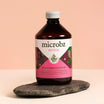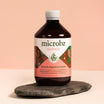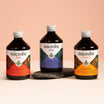Pomegranate
Punica granatum

Family: Lythraceae
Which probiotic is it in?: Pomegranate is a key herb in Sustain and Kids
Habit and cultivation: Native to Iran and now cultivated throughout the Mediterranean as well as regions of Asia, Europe and Africa. Loves a subtropical to mild temperate climate, and has now adapted itself to even cooler environments whilst producing a good supply of fruit. It is drought tolerant.
Actions (known for): Anthelmintic, astringent, anti-oxidant, anti-carcinogenic and anti-inflammatory.
History of Pomegranate
Parts used from the Pomegranate
Leaf
Constituents (bio available chemicals):
Essential oil 0.5 – 4%, primarily consisting of menthol and menthone. Flavonoids, tannins, triterpenes and bitter principles.
Nutritional constituents:
Vitamins: A, C and niacin. Minerals: magnesium, potassium, copper, iodine, iron, silicon, and sulphur.
Indications:
Aids indigestion, spasms of the GI, gallbladder, and bile ducts. Gastritis, enteritis, flatulence, IBS, constipation and diarrhea, common cold, Crohn’s disease, ulcerative colitis, nausea and morning sickness during pregnancy, headaches and asthma.
Dosage:
Liquid extract (1:2) 10 – 30ml per week. For upset stomach: 1tsp of dried or fresh herb made into a cup of tea and drunk 3-4 x daily. External analgesic: menthol in a cream no more than three times daily. Tension headaches: a light coating of tincture of oil applied to the entire forehead with finger tips; if there is occipital pain, apply also to back of neck. Nausea and vomiting: 3 – 6g or 5 – 10 drops of tincture in warm water and sipped slowly.
British Herbal Pharmacopoeia
Flatulence and digestive pain.
Cautions for therapeutic doses
Essential oil should not be applied directly to the skin. Peppermint oil is contraindicated by biliary tract obstruction, cholecystitis and severe liver damage. Should not be applied to facial area of babies and young children.




































